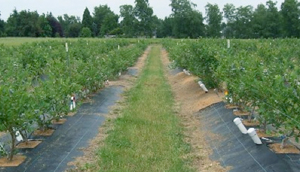
|
Our key findings to date are briefly described here. We highlight this planting at our annual Blueberry Field Day at the NWREC. More detailed progress reports are available upon request. Cumulative yield from years two - four (2008-10) was 48 percent greater on raised beds than flat ground, corresponding to improved plant growth. Although the soil at this research site is considered to be well-drained, there was still an advantage to growing on raised beds. Yields for the raised bed plantings have, in general, been similar to what is expected for conventional fields, averaging about four tons/acre in 2010 (year four). On average, plants fertilized with the high rate of feather meal or the low rate of fish emulsion had the greatest yield, whereas fertilizing with the highest rate of fish emulsion tended to reduce yield in both cultivars to date. Leaf tissue %N was higher than recommended levels in plants fertilized with the high rate of fish.Plants mulched with yard debris compost topped with sawdust (compost+sawdust) and weed mat produced greater yield than those mulched with sawdust in 2009 and 2010. Duke and Liberty had lower fruit firmness when fertilized with the low rate of feather meal than with fish emulsion or the high rate of feather meal. Duke fruit were firmer and had higher percent soluble solids (Brix) when fertilized with a high rate of fish emulsion. Our goal is to determine why fertilizer is affecting fruit firmness. Weed pressure has been consistently low with weed mat and high with compost+sawdust. In 2010, for example, sawdust+compost mulched plots required 83 hr/acre for hand-weeding and 20 hr/acre for contact herbicide application (total of 103 hr/acre + $60/acre product) compared to 88 hr/acre to hand-weed in sawdust and 18 hr/acre in weed mat mulched plots. Percent soil moisture was maintained in a suitable range for good plant growth through careful management of irrigation. In 2007-09 weed mat plots received approximately double the irrigation water as sawdust mulched plots, but in 2010 there was less difference in irrigation applied among treatments. Raised beds required more irrigation water than flat ground plantings in 2007-09, but not in 2010. We think these differences are mainly due to soil temperature as affected by mulch type or depth and plant canopy size (shading). Soil temperature was warmer under weed mat than under the organic mulches, particularly in raised bed plantings. Work on shoot growth rate, fruit bud set, tissue and soil nutrient status, soil microbial content, weed management, production economics, root growth and development of a compost suitable for blueberry were also conducted in 2009-2010 and work is on-going so please stay tuned! While this planting is still relatively young, growth and yield for most treatments have been similar to what has been observed in conventional systems. The best treatments so far have been growing plants on raised beds with a low rate of fish emulsion or a high rate of feather meal on either weed mat or compost+sawdust mulch. Economic returns to date have been comparable to conventional systems, depending on the organic production method used. We thank our advisory board members and the organizations that have provided funding for this project: The Oregon Blueberry Commission, the Northwest Center for Small Fruits Research, the Washington Blueberry Commission, the NIFA-OREI grant and industry contributors. |
Spotted Wing Drosophila Update Market
Outlook: Organic Blueberry Production Research Project Critical Program Needs Industry Support Small Growers to Receive GAP Certification Aid Oregon Fresh Season Promotion On a Roll for 2011 Smooth Move Increases Insulin Sensitivity New
Trap Hits OSU Researcher Driving Blueberries up a Tree USHBC Unveils New “Little Blue Dynamos” Positioning and Campaign for Highbush Blueberries Watching
World Acreage and Specialty
Crop Grant Supports Oregon Berry Festival;
|
